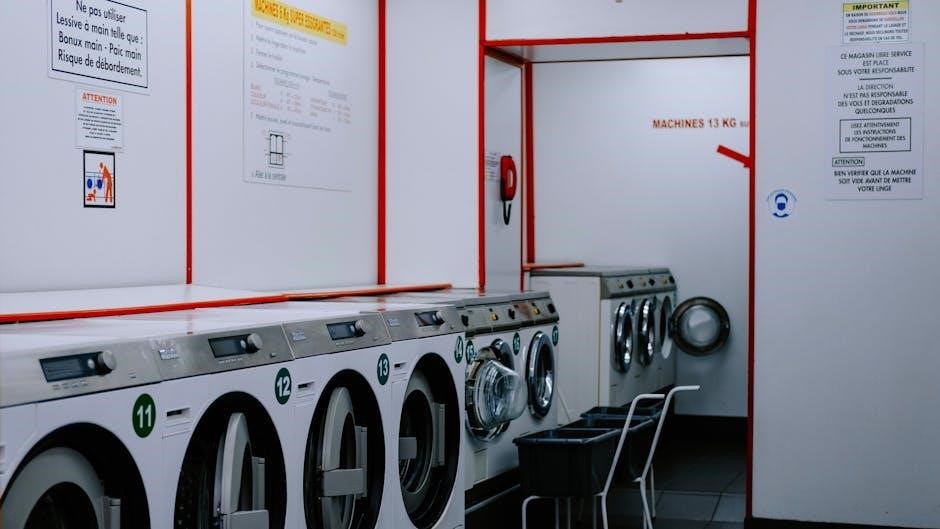
ScratchesHappen offers a user-friendly guide for DIY car scratch repairs, providing step-by-step instructions and professional tools. Their color-matched primers and paints simplify the repair process, making it accessible for all skill levels. With a focus on cost and time efficiency, ScratchesHappen helps car owners achieve professional-like results without the need for expensive body shop visits.
1.1 What are Scratcheshappen Instructions?
ScratchesHappen instructions are a comprehensive, step-by-step guide designed to help car owners repair scratches and paint chips like professionals. These instructions provide detailed methods for preparing surfaces, applying primer, painting, and polishing to achieve seamless results. They emphasize the use of color-matched primers and aerosol paints to ensure repairs blend perfectly with the vehicle’s original finish. The process is tailored for DIY enthusiasts, offering clear, easy-to-follow directions to fix scratches efficiently. By following these instructions, users can save time and money while restoring their car’s appearance to near-original condition.
1.2 Importance of DIY Car Repair
DIY car repair empowers vehicle owners to address minor damages like scratches and paint chips efficiently and cost-effectively. By tackling repairs independently, individuals save money typically spent on professional services. DIY methods also reduce time spent waiting for appointments or repairs. Scratcheshappen instructions simplify the process, making it accessible for all skill levels. Regular DIY maintenance fosters a sense of accomplishment and helps preserve the car’s appearance and value. It’s a practical approach to handle minor issues promptly, preventing them from becoming larger, more costly problems over time.
Materials Needed
Essential tools include sandpaper, brushes, and a clear coat. Scratcheshappen recommends color-matched primers, touch-up paint, and polishing compounds for a seamless repair. Gather these materials before starting.
2.1 Essential Tools for Scratch Repair
The essential tools for scratch repair include various grits of sandpaper (e.g., 1200-2000 grit), touch-up brushes, and a clear coat applicator. A polishing compound and a microfiber cloth are also necessary for blending and finishing. Additionally, a paint leveler or spray gun may be required for larger scratches. Scratcheshappen recommends using their professional-grade tools, such as aerosol paint cans and primer bottles, to ensure a precise application. Always prepare the area with masking tape to protect surrounding surfaces. These tools, combined with the right techniques, will help achieve a smooth and invisible repair. Gather all materials before starting the process for optimal results.
2.2 Recommended Products by Scratcheshappen
Scratcheshappen offers a premium touch-up paint kit designed for professional-grade repairs. The kit includes color-matched primers, aerosol paints, and clear coat sprays to ensure a seamless finish. Their aerosol paint cans are highly regarded for their precise application and even coverage. Additionally, Scratcheshappen provides sanding tools, polishing compounds, and microfiber cloths to smooth and blend repaired areas. Their products are backed by a color match guarantee, ensuring a perfect blend with your vehicle’s original paint. These tools and materials are essential for achieving a professional-looking repair without the need for specialized skills or equipment.

Surface Preparation
Proper surface preparation is crucial for a successful repair. Clean the affected area with a lint-free cloth to remove dirt and contaminants. Light sanding ensures a smooth finish, promoting better paint adhesion and a seamless blend with the surrounding surface. Always follow the instructions for optimal results.
3.1 Cleaning the Affected Area
Cleaning the affected area is the first step in surface preparation. Use a lint-free cloth and a mild detergent to remove dirt, grease, and contaminants. Avoid using harsh chemicals or abrasive materials that could damage the paint. Rubbing alcohol can also be effective for cleaning without leaving residue. After cleaning, inspect the area to ensure all imperfections are visible. Proper cleaning ensures better adhesion of the primer and paint, leading to a more durable and seamless repair. Skipping this step can result in poor paint adhesion and a less-than-desirable finish.
3.2 Sanding Techniques for Smooth Finish
Sanding is crucial for achieving a smooth finish. Start with 1200-1500 grit sandpaper, wet sanding the affected area to feather the edges of the scratch. Light pressure and steady strokes ensure even leveling. Avoid circular motions, as they can create swirl marks. After sanding, wipe away dust with a clean, damp cloth. Proper sanding ensures the primer adheres evenly, creating a seamless repair. For deeper scratches, progress to finer grits, finishing with 2000 grit for a polished surface. Sanding is the foundation of a professional-looking repair, making it essential to do it meticulously.
Application Instructions
Apply primer, paint, and clear coat as instructed, allowing proper drying time between coats. Follow the guide for a flawless, professional finish every time.
4.1 Applying Primer: Steps and Tips
Start by cleaning the scratched area thoroughly to ensure proper primer adhesion. Shake the primer bottle well and apply thin, even coats using a high-quality brush. Allow 5-10 minutes between coats, applying 1-3 coats as needed. Feather the edges to blend seamlessly with the surrounding paint. Work in a well-ventilated, dry space to prevent dust or moisture interference. Avoid over-application to maintain a smooth finish. Let the primer dry completely before proceeding to paint. This step is crucial for achieving a professional-like repair with a flawless final result.
4.2 Painting: Achieving the Perfect Coat
After priming, apply the color-matched paint in thin, even coats using a high-quality brush or aerosol. Start with a light coat, allowing 5-10 minutes to dry between layers. Typically, 2-3 coats are sufficient for optimal coverage. Feather the edges to blend seamlessly with the surrounding paint. Avoid over-saturating the area to prevent drips or unevenness. Once the final coat is dry, inspect the repair to ensure full coverage and a smooth finish. For added protection, a clear coat can be applied following the same process. Allow the paint to cure fully before exposing the vehicle to the elements.
4.3 Clear Coat Application for Protection
Once the paint is fully dry, apply a clear coat to protect the repair and achieve a glossy finish. Use a high-quality clear coat aerosol or brush-on product, following the manufacturer’s instructions. Start with a light, even layer, feathering the edges to blend with the surrounding area. Allow 10-15 minutes between coats, typically applying 1-2 coats for adequate protection. Avoid drips by spraying in steady, horizontal passes. After the final coat, let it cure completely according to the product’s instructions. This step ensures durability and UV resistance, maintaining your vehicle’s appearance for years to come.
Post-Painting Process
After painting, blend the repair area with the surrounding surface and polish for a seamless finish. This step ensures the repair is virtually undetectable, restoring your car’s original appearance.
5.1 Blending the Repair Area
Blending the repair area is crucial for a seamless finish. Use a blending brush to feather the edges of the painted area into the surrounding paint. Work gently to avoid over-blending, which can create unevenness. Focus on maintaining the natural glossy finish of your car’s paint. Light, soft strokes are key to merging the repair area with the original paint seamlessly. This step ensures the repair area is nearly invisible, restoring your car’s original appearance. Proper blending techniques, as outlined in Scratcheshappen’s guide, help achieve professional-like results without the need for advanced tools or expertise.
5.2 Polishing for a Seamless Finish
Polishing is the final step to achieve a flawless finish. Use a dual-action polisher with a soft foam pad and a high-quality polishing compound. Apply light pressure, working in small circular motions to buff the repair area. Gradually increase speed for an even gloss. Avoid over-polishing, as it may thin the paint. Inspect the area under different lighting to ensure a smooth, glossy finish. For minor imperfections, a handheld polishing tool can refine details. Polishing restores the paint’s original luster and blends the repair seamlessly with the surrounding surface, ensuring a professional-looking result with minimal effort and the right techniques.
Troubleshooting Common Mistakes
Troubleshooting common mistakes ensures a smooth repair process. Address issues like over-spray or uneven finishes promptly. Light sanding and touch-up paint can often resolve imperfections, restoring the desired appearance.
6.1 Avoiding and Fixing Over-spray
Over-spray is a common issue during DIY repairs. To avoid it, use masking tape to protect surrounding areas and apply thin, controlled coats of paint. If over-spray occurs, lightly sand the affected area using fine-grit sandpaper. Wipe clean with a lint-free cloth and reapply paint as needed. For larger mistakes, touch-up paint or clear coat can blend the repair seamlessly. ScratchesHappen recommends using their precision spray nozzles and following the step-by-step guide to minimize over-spray. Regularly inspecting your work and allowing proper drying time between coats can also prevent this issue. Fixing over-spray promptly ensures a professional finish.
6.2 Correcting Uneven Paint Finish
An uneven paint finish can occur due to improper application or environmental factors. To fix this, lightly sand the area using a fine-grit sandpaper (1200-1500 grit) to smooth out imperfections. Clean the surface thoroughly with a lint-free cloth to remove dust. Reapply paint in thin, even coats, allowing proper drying time between layers. For minor unevenness, a clear coat can help blend the repair. ScratchesHappen recommends using their touch-up paint kits for precise color matching and a seamless finish. Patience and careful application are key to achieving a professional-looking result. Always follow the instructions provided for best outcomes.

Advanced Techniques
ScratchesHappen offers advanced methods for handling deep scratches and mastering aerosol paint application. These techniques ensure professional results, even for complex repairs, with ease and precision.
7.1 Handling Deep Scratches
For deep scratches, Scratcheshappen recommends starting with thorough sanding to create a smooth surface. Apply primer in thin, even layers, allowing each coat to dry before proceeding. When using aerosol paint, spray in short, controlled bursts to avoid over-spray. Multiple thin coats are better than one thick layer for a professional finish. After painting, use a clear coat to protect the repair and blend it seamlessly with the surrounding area. This method ensures the scratch is virtually undetectable, restoring your car’s original appearance with minimal effort and expertise.
7.2 Using Aerosol Paint Effectively
For optimal results with Scratcheshappen aerosol paint, shake the can thoroughly before use and test the spray pattern on a separate surface. Apply thin, even coats, allowing each layer to dry completely. Avoid over-spray by maintaining a steady hand and keeping the can 6-8 inches away. Use primer first to ensure proper paint adhesion and a smooth finish. After painting, finish with a clear coat to protect the repair and blend it seamlessly with the surrounding paint. This technique ensures a professional-grade repair that is nearly invisible. Always work in a well-ventilated area for best results.

Preventative Measures
Prevent future scratches by using protective films and regular waxing. Park in shaded areas and avoid harsh chemicals to maintain your car’s paint integrity and appearance.
8.1 Tips to Avoid Future Scratches
To prevent future scratches, regularly wax your car and use protective films on high-risk areas. Park in shaded spots to avoid UV damage and abrasions from debris. Avoid harsh chemicals that can weaken the paint. When washing, use soft sponges and mild detergents to maintain the protective layer. Additionally, be mindful of tight parking spaces and avoid brushing against objects. Regularly cleaning your car helps identify minor scratches early, preventing them from becoming larger issues. These simple practices ensure your car’s paint remains intact and maintains its showroom appearance for years to come.
8.2 Regular Maintenance for Car Paint
Regular maintenance is key to preserving your car’s paint and preventing damage. Wash your car weekly with mild detergents and soft sponges to remove dirt and contaminants. Avoid using harsh chemicals or abrasive materials that can strip the paint of its protective layers. Waxing your car every 2-3 months creates a barrier against UV rays and minor scratches. Regularly inspect your car for small chips or scratches and address them promptly with touch-up paint. By following these routines, you can maintain your car’s paint in pristine condition and protect it from environmental wear and tear over time.

Before and After Results
ScratchesHappen delivers dramatic improvements, transforming damaged paint into a near-invisible repair. The final result is a seamless, professional finish that restores your car’s original appearance flawlessly.
9.1 Expectations from Scratcheshappen
When using Scratcheshappen, you can expect professional-grade results with minimal effort. The color-matched primers and paints ensure a seamless blend with your car’s original finish, making repairs nearly invisible. The step-by-step instructions guide you through preparation, application, and polishing, ensuring a flawless outcome. With Scratcheshappen, you can anticipate significant time and cost savings compared to traditional body shop repairs. The products are designed to be user-friendly, catering to both DIY enthusiasts and professionals. The end result is a restored vehicle appearance that meets high standards, proving that DIY repairs can achieve professional-like quality without the hassle or expense.
9.2 Customer Testimonials and Success Stories
Customers rave about Scratcheshappen, praising its ease of use and professional results. Many report that the color-matched paints and primers blend seamlessly with their vehicle’s finish, making repairs virtually undetectable. One satisfied user shared how the kit restored their Honda CRV’s appearance to near-new condition. Another highlighted the time and cost savings compared to body shop repairs. The consistent positive feedback underscores Scratcheshappen’s effectiveness in delivering high-quality, DIY-friendly solutions. These success stories demonstrate how the product empowers car owners to achieve professional-like results, boosting confidence in their ability to repair scratches and chips effectively.

Cost and Time Efficiency
ScratchesHappen offers cost-effective solutions, reducing expenses compared to professional repairs. The DIY approach saves time, delivering professional results without the need for body shop visits and lengthy waits.
10.1 Comparing DIY vs Professional Repair Costs
ScratchesHappen DIY repair kits offer significant cost savings compared to professional services. While professional repairs can range from $500 to $2,000 or more, depending on the damage, DIY kits are affordably priced under $100. This drastic price difference makes DIY a budget-friendly option for minor to moderate scratches. Additionally, DIY repairs eliminate the need for labor costs and reduce time spent waiting for body shop appointments. With ScratchesHappen, users can achieve professional-grade results at a fraction of the cost, making it a practical choice for car owners seeking affordability without compromising quality.
10.2 Time-Saving Benefits of Scratcheshappen
ScratchesHappen DIY repair kits are designed to save time, offering a streamlined process that eliminates the need for lengthy body shop visits. With step-by-step instructions, users can complete repairs in a fraction of the time, often within minutes. The kit includes pre-prepared materials, reducing preparation time. Unlike professional repairs, which can take days, Scratcheshappen allows car owners to fix scratches quickly and efficiently. This time-saving solution is ideal for busy individuals who want to restore their vehicle’s appearance without sacrificing precious time or waiting for appointments.
ScratchesHappen empowers car owners to achieve professional-grade repairs at home, saving time and money. With its innovative tools and clear instructions, it’s an ideal solution for a flawless finish.
11.1 Encouragement to Try Scratcheshappen
ScratchesHappen offers an accessible and efficient way to repair car scratches, making it easy for anyone to achieve professional-like results. With its innovative tools and clear instructions, this DIY solution saves time and money while restoring your vehicle’s appearance. Whether you’re a novice or experienced, Scratcheshappen’s color-matched paints and primers ensure a seamless finish. Avoid costly body shop visits and take pride in fixing your car yourself. The satisfaction of a flawless repair is just a few simple steps away—give Scratcheshappen a try and see the difference for yourself!
11.2 Final Tips for Successful Repair
For a flawless repair, patience and attention to detail are key. Always clean and sand the area thoroughly before applying primer or paint. Follow Scratcheshappen’s instructions carefully, ensuring proper drying times between coats. Work in a well-ventilated space with good lighting to avoid dust or moisture interference. Apply thin, even layers to prevent uneven finishes. Allow the final coat to cure completely before polishing. By following these steps and using Scratcheshappen’s color-matched products, you’ll achieve a professional-looking result. Take your time and trust the process—your car will thank you!